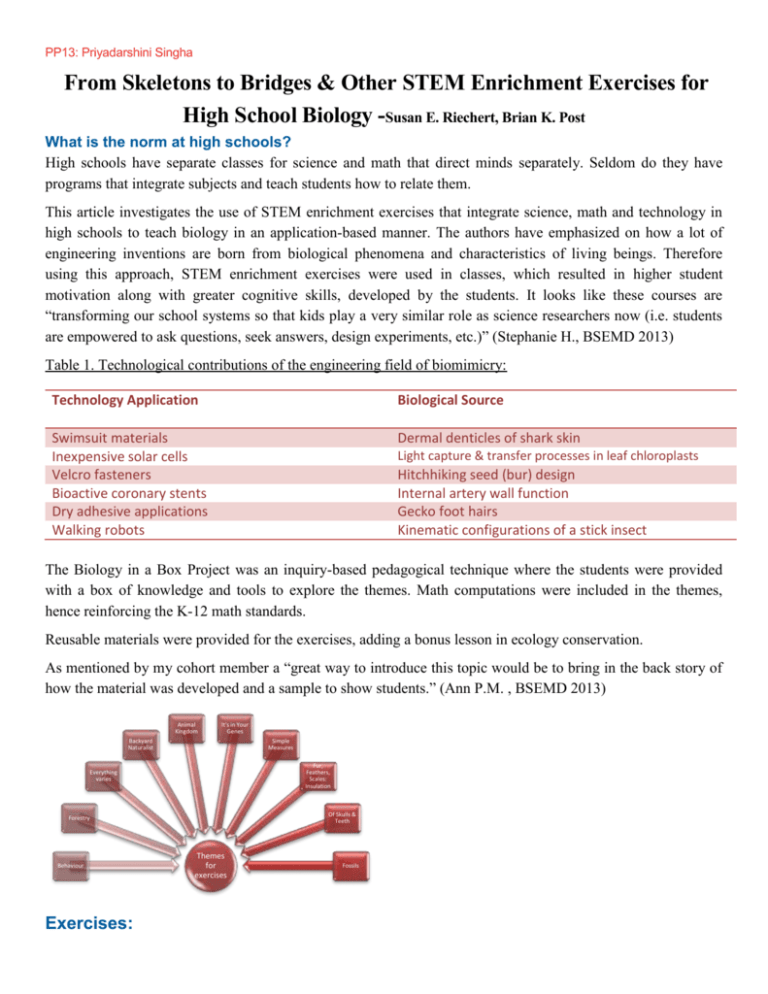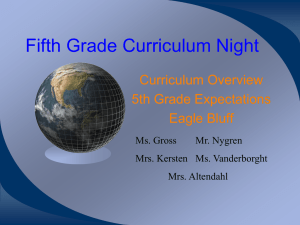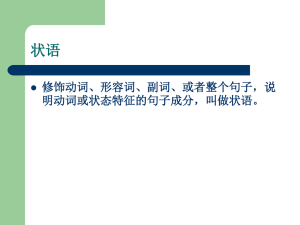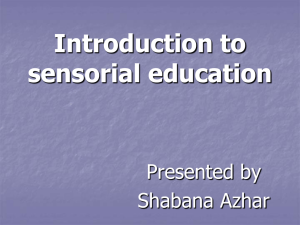Exercises - Sites@UCI
advertisement

PP13: Priyadarshini Singha From Skeletons to Bridges & Other STEM Enrichment Exercises for High School Biology -Susan E. Riechert, Brian K. Post What is the norm at high schools? High schools have separate classes for science and math that direct minds separately. Seldom do they have programs that integrate subjects and teach students how to relate them. This article investigates the use of STEM enrichment exercises that integrate science, math and technology in high schools to teach biology in an application-based manner. The authors have emphasized on how a lot of engineering inventions are born from biological phenomena and characteristics of living beings. Therefore using this approach, STEM enrichment exercises were used in classes, which resulted in higher student motivation along with greater cognitive skills, developed by the students. It looks like these courses are “transforming our school systems so that kids play a very similar role as science researchers now (i.e. students are empowered to ask questions, seek answers, design experiments, etc.)” (Stephanie H., BSEMD 2013) Table 1. Technological contributions of the engineering field of biomimicry: Technology Application Biological Source Swimsuit materials Inexpensive solar cells Velcro fasteners Bioactive coronary stents Dry adhesive applications Walking robots Dermal denticles of shark skin Light capture & transfer processes in leaf chloroplasts Hitchhiking seed (bur) design Internal artery wall function Gecko foot hairs Kinematic configurations of a stick insect The Biology in a Box Project was an inquiry-based pedagogical technique where the students were provided with a box of knowledge and tools to explore the themes. Math computations were included in the themes, hence reinforcing the K-12 math standards. Reusable materials were provided for the exercises, adding a bonus lesson in ecology conservation. As mentioned by my cohort member a “great way to introduce this topic would be to bring in the back story of how the material was developed and a sample to show students.” (Ann P.M. , BSEMD 2013) Animal Kingdom It's in Your Genes Backyard Naturalist Simple Measures Fur, Feathers, Scales: Insulation Everything varies Of Skulls & Teeth Forestry Behaviour Exercises: Themes for exercises Fossils 1. From Skeletons to Bridges This exercise involved the fundamentals of the famous comparisons between quadrupeds and bridges. It taught students how to construct bridges by using fundamental approaches of tension, compression and bending based on a biological characteristic. Exercise 1a: Determination of the force which limited a material (supplied from the box) the most. Exercise 1b: Student teams were formed and asked to design suspension bridges of specific spans by providing them with plastic connectors. Each team also drew their suspension bridges and showed the elements they had used for the construction. The class checked for the integrity of each bridge by applying different weights on them. Exercise 1c: This exercise involved teams competing against each other by designing a bridge with longer span and higher integrity. This was followed by the class reading up on Thompson’s chapter on vertebral column as a double-cantilever bridge. A second trial was carried out in case no group had applied Thompson’s principles to their design. These exercises were followed by different kinds of open-ended exploration like technological advances in construction that follow basic engineering principles. 2. Aerodynamics & Dispersal This exercise interconnects aerodynamics to dispersal by the presence of free fall and drag forces. Exercise 2a: Pairs of students dropped different items to the floor to see the effect of drag with respect to mass and cross-sectional area. Discussions would be followed after each drop. Results were included with teaching of the concept of drag and Newton’s 2nd law of motion so that students gained an understanding of the equation’s parameters. Exercise 2b: Student teams are assigned to modify a simple paper helicopter in such a way that it fell to the floor slower than before. They used paper and paper clips. This exercise would help in understanding the principles of drag force. Exercise 2c: This involved examination of various types of seed dispersal methods by dropping them from a similar height. The students would predict the fall pattern and also determine the lateral distance of the seed dispersals. The open-ended exploration could involve the morphological differences of seeds and their implementation of dispersal strategies. Students could design a different dispersal strategy by using their own-engineered seeds. “Inquiry leads an individual to relate and find answers from day – to – day activities and can bring some new ideas!” (Radhika M., BSEMD 2013) Conclusion “We live in a culture where everyone wants the same perfect experience as everyone else.” (Justin L., BSEMD 2013) The exercises while being very engaging and giving the students a total ownership of their short projects, could face a drawback when it came to standardized testing. But as suggested by a member of the cohort “Inventing a new product requires an individual to have background knowledge in a topic to be able to design the invention in a way that would best suit its usability. This alone could be a test for whether a student understands the scientific topic.” (Stephanie H., BSEMD 2013) The exercises are majorly team-based and hence a student could easily be left out while the rest of the team carries out the assignment. Is there a way that technology could play a pivotal role in that kind of situation? How could teachers make sure that every individual is being involved? Could technology like videos or interactive software be used more often to make the STEM enrichment exercise complete? “For media it may be possible to perform STEM using digital design programs like AutoCAD.”(Justin L., BSEMD 2013) The exercises have interconnected physics, math, biology and engineering in a very approachable manner and the collaboration with math teachers also make them easy to learn. It could be a “good way to use as Common Core; connecting different concepts into one assignment.” (Alice K., BSEMD 2013) This maybe easier to do at the high school level since the teachers have a better understanding of the subjects; however, would it be feasible to approach this technique at the middle school level? Maybe, teachers wouldn’t need to involve complicated engineering topics but would introducing STEM at the middle school level do more harm than good? Some of the advantages of these exercises: •Makes science a multidisciplinary experience. •No prior knowledge of the topic to be investigated is required by the students. This could make it approachable for non-science students too, who are interested in learning just one topic. •Teachers learn along with the students. •Mathematical computations find meanings! Equation parameters finally mean something to the biology students in high-school. •Inquiry-based exploration could be carried out in any of the field that the student is interested in. Some worries that may arise: •Being a team-based approach, some students could get left behind. •Time consuming for a single topic? •Sometimes it could be difficult for a student to relate the math to the biology. “It’s time education professionals stopped worrying about a test that takes place over 3 days of a 180 day school year and start thinking about the kind of application-based learning that will take students off the desks in front of them and into the 21st century.” (Ann P. M., BSEMD 2013)







